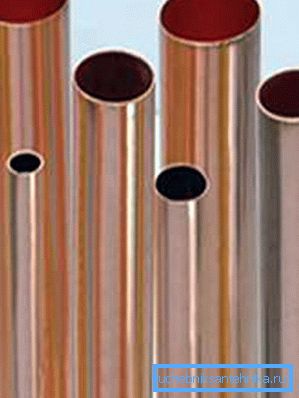Copper pipes for heating and their features
Copper pipes for heating and fittings are much more expensive than plastic and steel analogues. However, a large list of advantages makes them quite popular among professionals and ordinary consumers. In this article we will take a closer look at the features of this material, its advantages and disadvantages, as well as the method of installation.

Copper in the heating system
Advantages and disadvantages
Copper heating pipes have a number of objective advantages:
| Environmental friendliness | This material is a leader in terms of its harmlessness. According to this indicator, only some modern polymers can compete with it. In addition, copper has bactericidal properties. |
| Lifetime | Heating from copper pipes is almost eternal, since the material does not age and does not lose its properties. |
| Good specifications | The copper pipeline is not susceptible to corrosion, resistant to UV light, and the temperature range over which the system can operate is -200 +350 degrees Celsius. |
| Attractive appearance | The copper pipeline looks attractive throughout the entire life cycle. |
| High thermal conductivity | Copper is able to give maximum heat, so the use of copper radiators allows heating to reduce the cost of space heating by increasing the efficiency of the heating system. |
Note! Copper pipes for heating and water supply are resistant to chlorinated water, which is especially important when using them in urban apartments.

As for the deficiencies of copper, they include, first of all, the high price, as well as the relative complexity of installation, the feature of which we will consider below.
In addition, there are some features of the use of this material:
- When connected to aluminum sanitary products, electrochemical corrosion may occur.
- In the case of monolithic installation of the pipeline in the wall without a protective sheath, an electrochemical shell may occur, as this will lead to external corrosion. In addition, there is a risk of abrasive damage.
- Stray currents can have a negative effect on the pipeline.

Classification
Heating with copper pipes involves the use of pipe products of various sizes. To choose the right materials for the system, you need to familiarize yourself with their classification.
First of all, they can be divided by thickness into two types:
- Thick wall - wall thickness ranges from 0.8 to 10 mm. Production of these products is governed by GOST 617 - 90. In heating systems, as a rule, I use pipes with a thickness of 1-1.5 mm.
- Thin-walled - The wall thickness is 0.2–0.7 mm, so they are rarely used in heating systems.

In addition, the copper pipe for heating according to the method of manufacture is divided into:
- Drawn or cold-rolled (belongs to the category "D");
- Drawn from a welded billet (belongs to the category "C").
There are also classifications for:
- Diameter accuracy;
- The grade of the material;
- Plasticity, etc.
The last parameters in heating systems, as a rule, do not matter.
Note! The use of copper pipe products coated with a polymer shell, good reliable protection against stray currents.
Installation Features
The installation of heating with copper pipes is different from the installation of steel pipelines, as in this case soldering is used. However, contrary to the popular belief that this process is extremely complex, it can be done independently. To do this, you just need to understand the technology of soldering.

Note! Threaded installation of copper pipelines is practically not used, as it is not capable of providing the necessary tightness and durability of the connection.

So, the instruction for the implementation of soldering is as follows:
- The first step is to cut the pipe of the desired diameter and chamfer. I must say that chamfering is not a prerequisite, however, this procedure can significantly reduce the hydraulic pressure in the system.
- After chamfering, it is necessary to clean the outer surface of the pipe and the inner surface of the connecting pipe fitting with your own hands. To do this, you can use a synthetic sponge with hard fibers.
- Then on the cleaned areas should be applied flux.
- Next, you need to connect the parts and heat the place of joining with a gas torch. Heating is carried out to the melting point of the flux.

- After heating the parts to the required temperature, a bar of soft solder is applied to the site of the seam.
- If the stripping was of high quality, and the temperature was chosen correctly, the solder itself would melt and flow into the space between the parts to be joined according to the law of capillary movement of liquids.
After soldering, the joint can be cooled with water or left in the air. According to this principle, installation of copper pipes for the entire system in a house or apartment is carried out.
Here, in fact, all the features of the installation of the copper pipeline for the heating system.
Conclusion
Copper can be called one of the best and durable materials for the device heating systems. However, copper heat pipelines are extremely rare, due to their high cost.
From the video in this article, you can pick up some additional information on this topic.